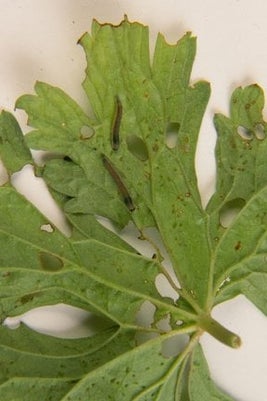
Quick facts
Common name - Geranium sawfly
Scientific name - Ametastegia carpini
Plants affected - Geranium
Main symptoms - Holes in leaves
Most active - May to September
What is geranium sawfly?
Sawflies are a group of insects suborder (Symphyta) of the Hymenoptera (bees, ants and wasps). There are about 500 species of in Britain. They have caterpillar-like larvae that feed on plant material and are named after the saw-like egg laying organ used by females to lay eggs in plant material. Adults can come in a range of colours many are black, green orange or striped yellow and black. Most are small (< 1 cm) but some species such as the Birch sawfly (Cimbex femoratus) can be over 2 cm long. Several species can be found in gardens and are part of the a healthy garden will support. More information can be found at The Sawflies of Britain and Ireland webpages
Geranium sawfly has greyish-green larvae that reach 12mm in length. The larvae feed on leaves of hardy geranium in May and September leaving a holed appearance. The larvae readily drop of the plants when disturbed and so are not often seen. The adult sawfly is a black 10 mm long fly-like insect.

Management
Although the damage on the foliage can be considered unsightly, it is generally not extensive enough to affect the plant’s growth or its ability to produce flowers and this insect can be treated as part of the a healthy garden supports.
- Where possible tolerate populations of geranium , this species rarely causes severe defoliation
- Encourage predators and other natural enemies of sawfly in the garden, such as birds, wasps and ground beetles
- Check plants regularly from May for the presence of larvae to prevent a damaging population developing
- Remove by hand if required and where practical
Biology
There are two generations a year of geranium with larvae present in May and September. Fully grown larvae pupate in the soil, the September generation overwintering in this state. Adults emerge in spring and lay eggs on the foliage.













